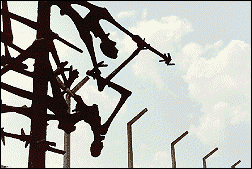Click here for www.PriceLine.com
E-Mail your question or solution to TravelASSIST.
 Where was this photo taken?
Where was this photo taken?
Stop back in JUNE for the next contest. Hope to add some more interesting prizes!
I visited Dachau in the summer of 1988 during a 2-month backpack/Eurorail trip through Europe. We had arrived in Munich from Atlanta but had neglected to go to Dachau so we made a special trip back to the area to see the camp. I remember being irritated that day because I had wasted $5.00 on a wrong ticket before finally boarding the correct bus. $5.00 isn't a lot of money, but that was a sixth of my daily $30 budget. After visiting the sight I was somewhat embarrassed by my reaction to such a trifling problem.
The town of Dachau had printed brochures that told of the history of not only the camp, but the area as well. Emphasis was placed on the fact that the town never elected Nazi party members to office and that the camp was established there for exactly that reason. Up to that time Dachau was more of an artists colony than anything else, the brochures wrote. Since my visit there I've seen the German film "The Nasty Girl" and it makes me wonder how much of that is true. Maybe it's completely accurate, maybe it's part half-truth or fiction. I don't know.
Like most visitors we didn't spend much time in the town itself and I have no lasting impression of it. The camp itself, however, is unforgettable. We were there on a bright, clear summer day, but there was a chill nonetheless. We passed over the trench and through the gate in the barbed wire fence and to the main building. It was once the command center but now it's the visitor's center. Inside this building (the sculpture stands in front of it, between it and the concrete slabs that were the foundations of the prisoner's barracks) is an extensive exhibit of photographs, military items and other displays that tell of life, and death, at the camp. It is difficult to grasp the horror that occurred there 50 years ago, but this exhibit tries to make everything as clear as possible.
The field where the prisoner's barracks were is huge and the concrete foundations are lined up in precise rows and columns. Though these barracks are no longer there, you can get a sense of just how many prisoners must have been here by the sheer size of this part of the compound. The lack of buildings here made the place seem hollow, which was somehow appropriate.
On the far side of the field are the buildings that housed, among other things, the ovens and the gallows. Both of these are still in these buildings and there are small signs that detail how they were used. I don't recall seeing large gas chambers and I'm not sure if these were present at Dachau.
Final impressions: The wind blowing across the field where the prisoners were housed. The rows of concrete slabs that made the place seem like a cemetery - bright green grass growing between them. We spoke very little, my friends and I, and when we did we hushed our voices. I used the term "hollow" above, but "hallowed" is perhaps a better descriptor. Apart from the wind, a few birds the few of us visiting, the place was still.
The Years of Terror - 1933-1945
The presence of the empty halls of the old powder factory was one of the reasons why Heinrich Himmler, the Munich Chief of Police, chose to erect the first Nazi concentration camp in Dachau. Between 22nd March 1933 and April 29th 1945, 200,000 prisoners passed through the Dachau camp and its branch camps. Over 23,000 died, through torture, execution, hunger or epidemics. The name of Dachau, the lovely, 1200-year-old town became synonymous all over the world for the inhuman terror of the Nazi regime.
The people of Dachau saw the prisoners building roads and later also working in the armament factories, and even though they didn't know the details of what was going on behind the walls of the camp, the townspeople were constantly aware of the "KZ" outside the town. Again and again there were attempts by Dachau citizens to help the prisoners covertly: They were slipped a slice of bread, a couple of potatoes were left on the kerb, a smuggled letter was passed on. When the end of the reign of terror was near, a few courageous citizens, with the help of a group of escaped prisoners, attempted to seize power from the Nazis in Dachau. The uprising was bloodily suppressed. On the next day, 29th April 1945, American troops liberated the concentration camp.
The surviving prisoners cheered their liberators, and the town, too, could hope for a new and democratic start.